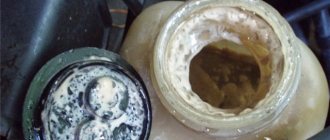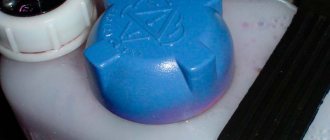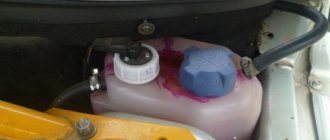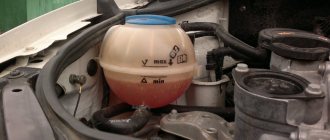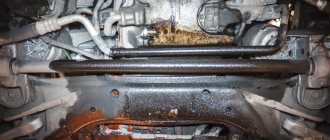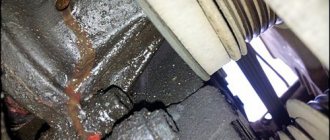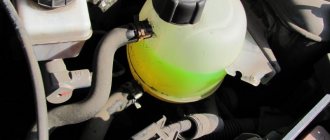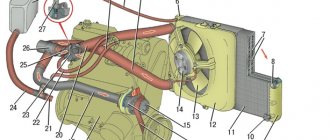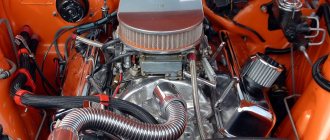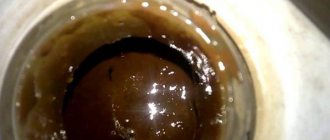Constant boiling of liquid in the car's cooling system should be taken as a serious malfunction, since it threatens to overheat the power unit. It is noteworthy that the phenomenon can arise due to minor problems, but lead to disastrous consequences if the defect is not corrected in a timely manner. Why antifreeze boils in the expansion tank of a car and what ways to deal with the malfunction is described in this publication.
About the operation of the cooling system
Without understanding the operating principle of the cooling system, it is difficult to diagnose the causes of problems and make repairs. The scheme operates according to the following algorithm:
- Until the engine is warmed up, antifreeze (antifreeze) circulates through a small cooling circle, which includes the engine water jacket, heater and thermostat. The fluid level (abbreviated as coolant) in the expansion tank remains within normal limits.
- As the engine heats up, the thermostat opens a large circulation circuit through the main radiator. The antifreeze in the system expands and its excess enters the tank. The increasing pressure is released by the bypass valve of the cover.
- When 95°C is reached, all liquid passes through the main radiator and expands to its maximum volume. The excess is discharged through the additional upper radiator pipe, so it seems that the antifreeze is boiling in the container.
- Cooling of the power unit leads to compression of the coolant to its original volume and a drop in pressure. To prevent vacuum from occurring, the bypass valve of the expansion tank plug allows outside air into the system.
Reference. Some car models provide for 2 discharges of excess antifreeze into the tank - from the radiator and the cabin heater.
Depending on the design of the cooling system, the cap with the valve is installed on the expansion tank or the radiator neck. In the second case, liquid discharge begins after a certain pressure is exceeded, and the tank is constantly connected to the atmosphere through a hole in the plug.
Boiling due to overheating
To begin with, we should separate 2 concepts - boiling of coolant as a result of overheating and bubbling of antifreeze in the expansion tank. The first malfunction is accompanied by a temperature jump above 115 °C (with such heating, the coolant begins to boil) and occurs due to the following reasons:
- the thermostat damper is stuck in the slightly open position, the liquid moves along a small circuit and does not have time to cool;
- the sensor that turns on the electric fan has failed;
- the honeycombs of the main radiator are heavily clogged;
- an air lock has formed in the system, preventing normal circulation;
- the pump shaft is jammed or broken, the pump impeller has crumbled;
- antifreeze is too diluted with water boiling at 100 °C.
If the coolant boils for one of the above reasons, the engine overheats and may fail at any time.
When exposed to high temperatures, aluminum pistons increase in diameter and lift up steel cylinder liners. A driver who notices the readings of the coolant temperature gauge and does not turn off the engine runs the risk of changing the piston group with the cylinder bore, sometimes along with the crankshaft. When you notice a critical jump in the thermometer needle on the dashboard to a temperature above 110 ° C, immediately stop the engine and find out the causes of boiling and overheating. Premature major repairs are not cheap.
Why the car boils: causes of coolant overheating
The cooling system in a car is one of the main peripheral organs that ensures normal engine operation. Antifreeze pipes pass through the most dangerous areas of the engine for overheating, and are also connected to the interior heater, which makes the system multifunctional and very important for the normal operation of the car. Do you think that the stove is not such an important element of comfort and overall usability? Try driving in 20-degree frost without it. You will clearly feel all the delights of such operation and will be able to understand exactly how important this element is in the car. But the stove is only part of the cooling system. The main parts of its operation are the thermostat, pipes through which coolant circulates, as well as a radiator for cooling antifreeze or antifreeze.
If one of these elements is not working properly, there may be a problem with the cooling system. Such problems will lead to the engine overheating, the pistons will change sizes due to metal expansion when heated, friction will increase significantly, and the engine will simply fail. It is important to notice overheating in time to eliminate this process and remove all risks from operating your own car. That is why the dashboard in any car contains information about what the coolant temperature is at the moment. Let's look at what problems cause the machine to boil.
How dangerous is bubbling antifreeze?
This phenomenon is considered normal when the engine is warmed up to an operating temperature of 90–95 °C, provided that there are no losses of coolant, leaks outside the tank and other abnormal signs. Part of the antifreeze circulating in a large circle is discharged into the expansion tank. To an inexperienced car enthusiast, it may seem that it is boiling, although in reality an intense discharge is taking place.
Important point! A sign of serious danger to the engine is an increase in coolant temperature. If the device does not show it, overheating is excluded.
Not all seething is harmless. If it occurs on a cold engine and is accompanied by side symptoms, there is a reason to check the condition of the cooling system. What these signs and possible malfunctions look like:
- Antifreeze suddenly begins to bubble 2–5 minutes after stopping the engine. Most likely, the problem is a faulty valve built into the radiator cap. When circulation stops, the fluid in the cylinder head quickly heats up and increases in volume. Since the radiator valve is open, it rushes into the tank through the upper outlet pipe.
- Seething and drips on the expansion tank body indicate a stuck plug valve. Air and steam break out at a weak point - along the plastic thread, but they can also “explode” the container.
- There is a large amount of white smoke coming out of the exhaust pipe, and streaks are visible on the cylinder block. The reason is a broken gasket between the block and the cylinder head. The gas pressure created by the pistons is transmitted to the cooling system, causing the antifreeze to bubble and boil in the expansion tank.
The engine is overheated - reasons
Why do engines boil is a question that interests many car enthusiasts. After all, no one wants to be in the middle of the street with a car with a column of steam literally pouring out from under the hood. Among the most common reasons, experts name the following options:
- Thermostat malfunction
- Pump problems
- Leakage of fluid responsible for cooling the engine
- The appearance of air plugs in the system
- Fan doesn't work
In each specific case, correction of the situation and various types of repair work will be required.
Thermostat is faulty
When the thermostat gets stuck opening, difficulties and interruptions begin. The liquid responsible for cooling in the car passes only to circulation in a small circle - it is also called a cooling jacket, bypassing the radiator. And this failure cannot be noticed externally.
Some signs that the thermostat is no longer working at full capacity include:
- The engine slowly warms up to a temperature called operating temperature.
- The lower radiator hose begins to heat up quickly - in just a couple of minutes even after a cold start
- When accelerating, the arrow of the temperature sensor first falls, and when stopping or idling it rises
It is worth taking a close look at the behavior of your car to sense a malfunction.
Pump faulty
If the pump fails, the liquid ceases to be properly pumped through the cooling system. Problems with pump operation may occur due to:
- Wear parts
- Impeller destruction
- Drive problem
It is worth understanding that the pump has a certain resource, after which it may well break. Experts estimate the lifespan of the pump at 80-100 thousand km. And this parameter is even included in the maintenance regulations.
Coolant leak
If antifreeze or antifreeze of questionable quality is frequently used, or if the car is operated in conditions where there is a temperature difference, malfunctions in the operation of the cooling system may occur. For example, tubes fail. Against this background, leakage easily begins.
In addition, depressurization of the coolant can occur against the background of:
- Wear of seals
- Weaknesses in tightening clamps
- Presence of cracks in hoses
- Radiator problems
- Difficulties with the heater tap
Against the background of all this, the liquid begins to flow out and evaporate, its quantity drops sharply and becomes insufficient to properly cool the engine.
Air locks in the cooling system
Often the catalyst for the problem is air plugs that form in the system. Such defects appear when:
- Violation of tightness in those places where the tubes connect to the nozzles - here, when the liquid passes, low pressure will appear, air will begin to be drawn in and form stagnation
- Air entering the system when replacing or adding coolant
- Malfunction of the expansion tank valve - in general it is necessary to get rid of excess air in the system, but if there is a malfunction, on the contrary, it begins to draw it in
- Pump leakage
- Presence of external defects in the radiator shell
The air lock can be expelled from the cooling system yourself. There are several different options - some are good for domestic cars, others are also used for foreign cars.
Fan doesn't work
If, based on the results of the inspection, it turns out that the antifreeze level is normal, but the engine still heats up and even boils, they may recommend checking the fan. In such a situation, it will not be possible to cool a heated engine if the car is standing or driving at low speed - after all, the radiator will not be blown with air towards it. Otherwise the temperature may even out.
There can be many reasons for fan failure. These include malfunctions in the operation of the power connectors, problems in the wiring, and malfunctions in the fan drive; the temperature sensor responsible for turning on the blower may fail.
It is possible to correct the situation yourself. To do this, you first need to determine why the fan failed. First you should check the electric motor. To do this, just take two wires, connect directly to the fan and power it from the battery. If it starts, then this is not the problem.
How to fix the problem?
When the antifreeze boils in the expansion tank and the thermometer needle shows 110 °C or more, you need to turn off the engine and check the following points:
- Try the bottom of the radiator with your hand. If it remains cold, the problem lies in the thermostat. Allow the engine to cool and slowly get to the garage or service station. A faulty thermostat must be replaced; it cannot be repaired.
- Connect an electric fan that does not work on time directly to the battery and continue moving towards a familiar auto electrician who can make an accurate diagnosis.
- It is impossible to determine the degree of radiator clogging without disassembling the system and dismantling the element. Check this version last.
- Jamming and destruction of the pump is accompanied by a sharp jump in the temperature of the antifreeze and leakage of the water pump seal. The part will have to be replaced; driving further is unacceptable.
- The signs of an air lock are identical to the symptoms of a thermostat malfunction. Another thing is that it does not appear out of nowhere: most likely, you unsuccessfully filled the system with antifreeze.
To remove the air lock, remove the hose at the highest point of the system (usually the throttle body) and add fluid to the container until it flows from this pipe.
Now let’s talk about what to do with a faulty expansion tank or radiator cap. The best solution is to replace the defective element; repairs only help for a short time. At the same time, check the condition of the plastic container for cracks that may appear as a result of liquid and steam pressure. Driving with a jammed bypass valve is extremely undesirable.
The gasket between the head and the cylinder block is replaced immediately . A mixture of oil and antifreeze will cause a lot of trouble, including water hammer and destruction of the walls of the combustion chamber in a diesel engine. Please note that gasket failure is not always accompanied by white smoke from the exhaust pipe, so monitor the color and consistency of the coolant in the expansion tank.
If you happen to encounter antifreeze boiling on the road, check the system elements according to the instructions presented above. Three reasons will not allow you to get to the service station under your own power - pump failure, a crack in the cylinder head gasket and complete loss of fluid. In other cases, you can move, making stops to cool the power unit. If antifreeze leaks, temporarily add distilled water to the system.
I replaced the sensor on the ECU. Through the openiag it shows a temperature of 93 degrees and the liquid begins to boil; when you remove the connector, the fan turns on through the openiag too. I don’t know where to drip.
Comments 101
I solved the problem at the spotter by changing antifreeze to antifreeze
It's bullshit about the lid, I specially removed the lid, the fan turns on at 102 degrees, nothing boils, with the lid open!, if everything is working properly, without the lid it shouldn't boil, provided that the liquid is normal
Thank you all for your help, the problem turned out to be the lid, the Luzarovskaya one had a slightly different thread, which is why it didn’t screw on tightly, one VAZ one had a crack, and the other’s valve was very badly eaten by rust, I assembled one lid from them, the Luzarovskaya filling was in the VAZ lid and everything fell into place
If it boils at 93, it means there is no pressure in the system, provided that the temperature seems correct. Change the tank cap.
What to do in case of boiling?
If Antifreeze is boiling, smoke is coming from under the hood, and the engine temperature gauge needle shows more than 100 degrees, then you need to do the following:
- First you need to immediately stop loading the motor. That is, you need to engage neutral gear and move until it comes to a complete stop, without turning off the engine. At the same time, turn on the heater or fan so that the engine cools down at least a little;
- After stopping the vehicle, the engine must be turned off, but the stove does not need to be turned off. A working heater will allow the engine to cool down a little;
- open the hood of the car to provide airflow to the engine;
- then you need to wait 20-30 minutes;
- It is strictly not recommended to open the expansion tank with coolant, otherwise hot antifreeze may simply spray out of it and burn the driver’s skin;
- when 30 minutes have passed, look for someone to take you to the service station. You can take the car towed or call a tow truck;
- if going to a service station is not an option, then open the expansion tank and add refrigerant, then close the hood and drive to the nearest service station with the heater on. Look how much fluid is in the expansion tank. If it is not there, then do not rush to fill in the refrigerant: sudden cooling is harmful to the system. In this case, it is necessary to control the engine temperature: if it exceeds 100 degrees, then stop the car and wait until the temperature drops. If the temperature goes beyond 100 degrees several times, then there is a possibility of motor failure. If the engine misfires, then it is necessary to change the gasket on the cylinder block;
Sediment in the pipe after using low-quality refrigerant
If you have the necessary knowledge, you can try to fix the breakdown on the spot.
To do this, you need to diagnose the parts and, if necessary, replace:
- thermostat;
- clean the cooling radiator;
- replace the pump;
- change the fan;
- disconnect the pipes from the thermostat and get rid of the air lock;
- Replace the antifreeze temperature sensor.
It is better to entrust such work to a specialist if you are not confident in your abilities. The temperature of the engine must be constantly monitored to prevent such malfunctions from occurring, but if it boils, then follow the steps described above.
Damage to connections and hoses
First of all, you need to open the hood, look at the level in the expansion tank and, if it is below the mark, look for a possible fluid leak.
- Presence of stains and smudges.
- Integrity of connecting tubes.
- Tightness of connections between pipes, expansion tank and radiator.
- Tightness of the expansion tank cap.
If damage to the hoses or connections is detected, or the seal of the lid is broken, you can slowly, with frequent stops (as soon as the temperature arrow enters the red sector) to allow the liquid to cool, drive to the nearest service station. All other types of damage can be eliminated only after towing; it is better not to move under your own power.
The expansion tank cap must be screwed in when the engine is cold. In addition to the cap, check the integrity of the threads on the expansion tank.
If a visual inspection does not give any results as to why the VAZ 2114 is boiling, the reasons are most often damage or malfunction of the system elements.
Precautionary measures
The driver must know that:
- When antifreeze is boiling, it is strictly forbidden to open the cap of the expansion tank or the radiator neck, as you can get extensive burns due to the massive cloud of hot steam.
- You cannot check the heating of pipes and radiators with your palm turned on. For this, either thermocouples or thermometers with infrared sensors are used.
- Antifreeze is a toxic substance. Under no circumstances should you “taste” it. Even a few drops can lead to very serious consequences.
In total, the above reasons are the most common, which is why antifreeze begins to boil or simply “bubble” in the expansion tank. If you cannot determine the nature of the breakdown yourself, then it is better to contact experienced specialists from a service station. But you shouldn’t allow the engine to overheat regularly, since repairing a jammed cylinder block is not a cheap “pleasure.”
Preventive measures
To avoid cooling system malfunctions, you need to buy high-quality antifreeze from trusted auto stores and services. If everything worked before replacing the antifreeze, but after the replacement the system boiled, most likely the reason was poor-quality antifreeze.
A sign of fake antifreeze is its boiling over at a temperature on the dashboard of 90 °C. In this case, if the VAZ 2114 boils at 90 degrees, a complete drain of the fake and flushing of the entire cooling system is required.
When purchasing antifreeze, you need to pay attention to both the boiling point and boiling pressure. If the pressure does not match atmospheric pressure, recalculate the temperature. For example, at the promised 135°C-1.2 atm. antifreeze will boil at 100°C-1 atm (if the atmospheric pressure is normal, it will boil at 100°C).
During a daily inspection of the engine compartment with the engine running, you can detect fluid leaks, ruptures in connecting pipes and contamination of the radiator.
To prevent the engine from overheating, you need to set the fan activation temperature on the on-board computer to 95°C (change from the factory setting to 102-105°C).
Basic functions of antifreeze
What is antifreeze? This is the liquid that circulates in the cooling and heating system of a car. It removes excess heat from the engine and, if necessary, heats the interior. Antifreeze (antifreeze) contains antifreeze and anticorrosion additives. Usually the number after the brand name indicates the freezing point of the antifreeze.
The boiling point of high-quality antifreeze is +108-125 °C. This temperature is maintained with a sealed and properly functioning system.
Antifreeze boiled
Over time, antifreeze loses its qualities and must be changed regularly (at least once every 3-5 years).
If signs of boiling appear, stop and cool the engine. If you know that the shelf life of the antifreeze in the system is fine, you need to look for why the antifreeze is boiling in the expansion tank of the VAZ 2114.
If antifreeze is boiling, it is better to get to the nearest car service center as quickly as possible. Otherwise, the cooling system and an overheated engine will require serious repairs and investment. With frequent boiling, the service life of the engine is reduced by 2-3 times.
What to do if antifreeze boils

